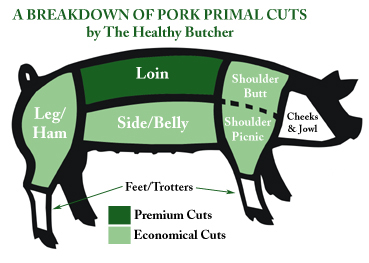
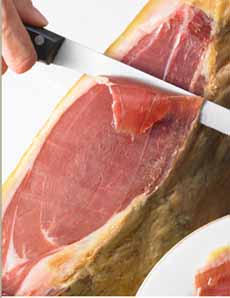
A boneless leg of serrano ham (photo © La Tienda).
April 2015
Last Updated September 2023
|
 |
Types Of Ham
A Glossary
The ham comes from the back legs of the pig: It comprises the thigh and rear end of the pig. The bone is often left in, which adds flavor and includes the rump (the upper portion), the center, and the shank (the lower portion).
The upper part of the leg (above the knee) is called the shank end; the bottom of the leg produces trotters. Ham can be cured or fresh. Different countries use different methods of curing and cooking the ham, as you’ll see in the hams below.
While today ham is the food of Everyman, for a long time it was an elite meat: enjoyed by royalty and served by the affluent on special occasions. In the Roman Empire, it was served to emperors and their guests. Check out the history of pork and see our many other food glossaries, including our Pork Cuts Glossary.
This glossary is protected by copyright and cannot be copied in whole or in part.
You are welcome to link it.
Ham is made from the back left of the pig. Chart © The Healthy Butcher.
|
AUSTRIAN HAM
A style where selected lean ham pieces are placed in a large casing, then baked and smoked.
BAKED HAM
According to federal regulations, baked ham is a ham “cooked by direct action of dry heat and reaches an internal temperature of 170°F.
BAYONNE HAM
A boneless, dry-cured ham from France. It is salted and air-dried for six months in the Pyrenees and the south of France. It is named after the port city of Bayonne in southwestern France.
|
|
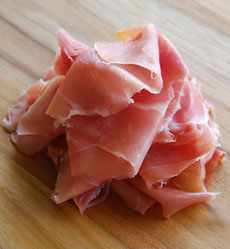
Bayonne ham (jamon bayonne), sometimes called the “French prosciutto” (photo © Murray’s Cheese). |
|
BLACK FOREST HAM
A round, boneless, dry-cured ham initially soaked in caramel to encourage the development of a dark surface. It is cooked with heavy smoke from pine or fir branches.
BOILED HAM or COOKED HAM
Called cooked ham by the USDA), boiled ham is a bland, non-smoked ham that is cooked by steaming or immersing in hot water. It is generally used as a luncheon meat.
BRESAOLA
Bresaola is not ham but beef. It is air-cured and salted like prosciutto and is a meatier alternative for those who prefer beef to pork. Bresaola is aged for two or three months until it becomes hard and turns a dark red, almost purple color. A product that originated in Valtellina, a valley in the Alps of northern Italy’s Lombardy region, bresaola is made from top-round beef. It is lean and tender, with a sweet, musty smell.
|
|
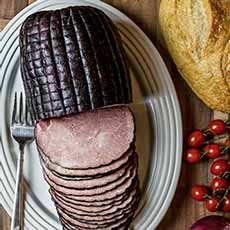
Black forest ham with its signature dark surface (photo © Buy Pork).
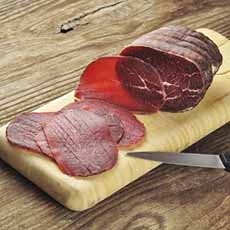
Bresaola (photo © Olli Salumeria Americana | Facebook). |
|
COUNTRY HAM
Country ham is a dry-cured specialty ham that originated in the southeastern U.S. Different regions use different recipes, but most are salty and smoky, with flavors of hickory, honey, or maple.
COPPA or CAPICOLA or CAPICOLLO
Coppa (the Italian word for neck) is a shoulder ham, an Italian cured meat that tastes similar to prosciutto and can be used interchangeably. The difference between the two meats is that coppa is made from the pork shoulder or neck, while prosciutto is made from the thigh and buttocks. Coppa is made in both hot and sweet varieties.
|
|
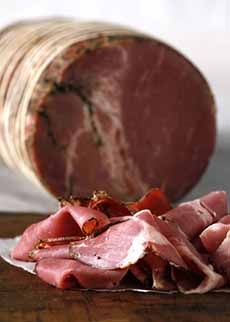
Coppa, shoulder ham (photo © DeLallo). |
|
GUANCIALE
Guanciale (gwan-CHA-lay) is not ham, but cured pork jowl (pork cheeks) similar to bacon, but unsmoked (see our Bacon Glossary). Guanciale is a specialty of central Italy, particularly the Umbria and Lazio regions. Pancetta, a cured Italian bacon that is normally not smoked, is sometimes used as a substitute when guanciale is not available.
Its name derives from guancia, the Italian word for cheek. The pork cheek is rubbed with salt and spices (black or red pepper, thyme or fennel, and sometimes garlic) and cured for three weeks or until it loses approximately 30% of its original weight. Its flavor is thus stronger than pancetta. It is an ingredient in pasta dishes like spaghetti alla carbonara and sauces like sugo all’amatriciana.
|
|
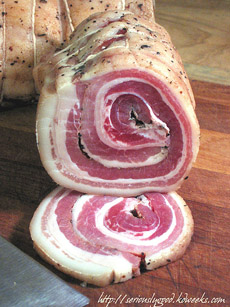
Guanciale, cured pork jowls (photo © KD Weeks). |
|
HAM HOCK
The ham hock is not a type of ham, but the joint between the tibia/fibula and the part of the foot where it is attached to the pig’s leg. This cut generally has too much skin and gristle to be eaten directly. Instead, it is often cooked with greens and other vegetables, or in soups, to provide a smoky pork flavor. Try it in this delicious recipe for barbecue pork butt (pulled pork).
|
|
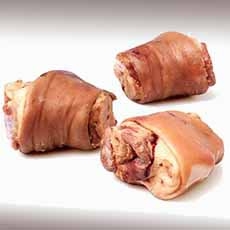
Smoked ham hocks (photo © Fresh Direct). |
|
HICKORY SMOKED HAM
A ham that gets a distinctive hickory flavor from smoking over hickory chips. Lesser hams use liquid smoke.
HONEY- OR MAPLE-CURED HAM
A ham cured with honey or maple syrup instead of sugar.
JAMBON BAYONNE
See Bayonne ham, above.
|
|
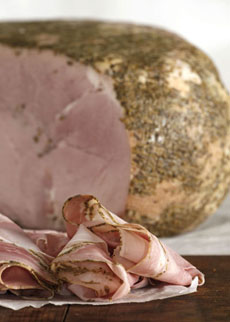
A hickory-smoked, rosemary-crusted ham (photo © DeLallo).
|
|
JAMÓN IBÉRICO or JAMÓN DE PATA NEGRA
Jamón ibérico de campo (jamón ibérico for short) is also known as jamón de pata Negra, of the the black-hoof, named after the black-hoofed Iberian pig (cerdo ibérico). There are three grades of jamón ibérico: pasture- and grain-fed jamón ibérico de campo; jamón ibérico de recebo, which is acorn, pasture and corn-fed; and jamón ibérico de bellota, free-range and acorn-foraging, which can cost twice as much as a jamón ibérico de recebo. The ham is dry-cured for 24 months and the product is a great luxury: The jamón ibérico de campo costs about $89.00 a pound, or $800 for a 9-pound boneless ham. This is the ham commonly served at tapas bars (and now you know why those slices are so thin!).
Sweet and nutty, jamón ibérico is a luxury product. To test how much you like it, taste it alongside the much more affordable Serrano ham.
Pata negra only accounts for about 5% of total ham production in Spain. The best pigs are fattened (finished) by rooting free-range on acorns, in the groves along the southern border between Spain and Portugal. This is the famous (and famously expensive) jamón ibérico de bellota (acorn-fed ). The physical activity in the forest creates highly-marbled meat with rich, golden fat that is full of antioxidants. This ham is cured for 36 months—a very long time enabled by the high-fat content and the antioxidant quality of the diet. Jamón ibérico de campo and jamón ibérico de recebo are still excellent hams, but not as spectacular as the bellota ham. Enjoy it as a first course with a side of warm toast. Read more about jamón ibérico. Also see ibérico pig and pata negra.
|
|
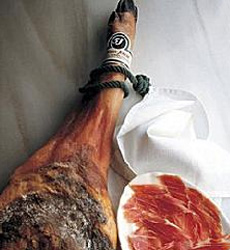
Black-hoofed pata negra. Photo courtesy Cinco Jotas.
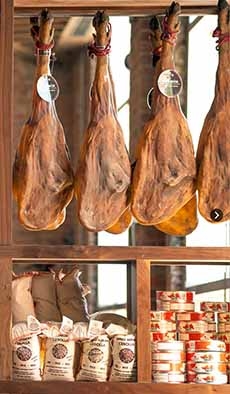
Jamón ibérico hanging in a shop (photo © Toro Tapas Bar | NYC [now closed]).
|
|
PANCETTA
Pancetta is not ham, but a kind of Italian bacon, made from pork belly that's salt-cured and aged. Unlike bacon, pancetta can be eaten in its raw state; in fact, it's equally delicious eaten raw or cooked. Raw pancetta is typically eaten in thin slices; cooked bacon is usually diced when added to cooked recipes, where it adds rich, salty pork flavor to food.
|
|
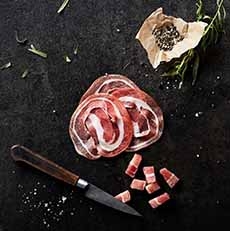
Pancetta (photo © Columbus Craft Meats | Facebook). |
|
PARMA HAM or PROSCIUTTO
Prosciutto is the Italian word for ham. The term prosciutto is almost always used for a dry-cured ham that is usually sliced thinly and served uncooked; this style is called prosciutto crudo in Italian and is distinguished from cooked ham, prosciutto cotto. The finest prosciuttos are PDO-protected: Prosciutto di Parma (Parma ham) is from the Parma region of Italy. They are considered “sweet” (not too salty). They are aged for 400 days, cured with salt only (hence the delicate pink color). Most prosciutto is pressed by a machine to achieve the flat shape. The word prosciutto derives from the Latin pro (before) and exsuctus (past participle of exsugere “to suck out”) and refers to the sucking out of the moisture in the ham by the mountain winds, which whipped through the sheds where the hams were hanging.
|
|
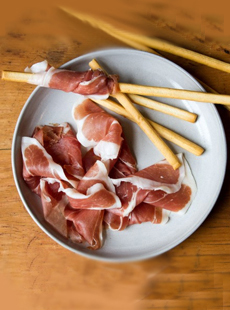
Prosciutto de Parma (photo © Murray’s Cheese). |
The modern Italian verb prosciugare means “to dry thoroughly.” See the differences between prosciutto and serrano hams, below.
|
PROSCIUTTO SAN DANIELE
Prosciutto San Daniele, which is also PDO-protected, is made in the Friuli Venezia Giulia region of northeast Italy. It is produced by a consortium of 30 members. As with prosciutto di Parma, prosciutto di San Daniele is crafted from the hind legs of hogs raised to 9 months or more. The legs are rubbed with salt and spices, and air-dried (aged) for 13 months. The moister, cooler climate of Friuli-Venezia creates mild and delicate meat with a melting, velvety texture. Pair it with slices of cantaloupe or wrap spears of roasted asparagus in slices as an appetizer. The ham goes especially well with the crisp pinot grigios of Friuli-Venezia.
|
|
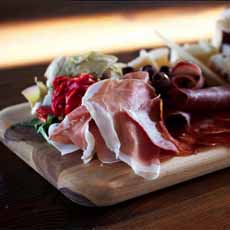
Prosciutto San Daniele. Photo courtesy Due Forni | Las Vegas. |
|
SERRANO HAM
Serrano ham is a dry-cured Spanish ham that is generally served in thin slices, similar to the French jambon bayonne and Italian prosciutto crudo. See the photo at the top of the page.
See the differences between prosciutto and serrano hams, below.
SPECK
Speck is a boned ham dry-cured in a similar manner as prosciutto. At the end of curing it is lightly smoked. The finest is a PDO-protected Speck Alto Aldige, from the north of Italy. Here’s more about it, and a comparison of prosciutto and speck.
|
|
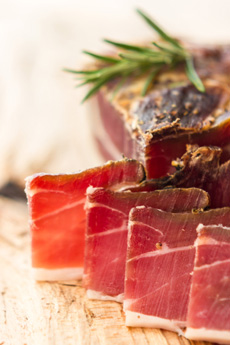
Speck Alto Aldige, a PDO-protected artisan product. Photo by F.P. Wing | IST. |
|
TASSO HAM
Tasso, a Creole specialty, is not exactly ham. It is not made from the hind leg of the pig but from the pork butt. The butt is dredged in a salt cure for a few hours, then rinsed, rubbed with a hot spice mixture containing cayenne pepper and garlic, and then hot-smoked. It can be eaten on its own but is more often used to add flavor to stews, braises, and dishes ranging from pasta to crab cakes to soup and gravy. It’s a “must” in jambalaya.
VIRGINIA SURRYANO HAM
This American ham is made in the Serrano style (hence the play on words) by Edwards Smokehouse of Virginia. It is crafted from pasture-raised heritage Berkshire hogs; hand cured, hickory smoked, and aged. Try it alongside a slice of Serrano ham to see which you prefer.
|
|
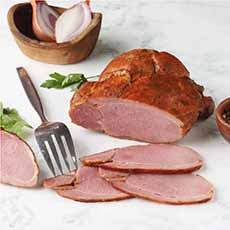
Tasso, not exactly ham but pork butt (photo © D’Artagnan).
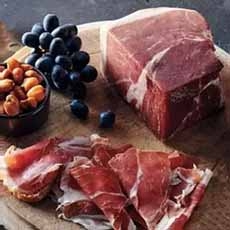
Surryano ham was developed as an American alternative to Europe’s dry-cured hams (photo © Edwards Smokehouse).
|
THE DIFFERENCES BETWEEN PROSCIUTTO & SERRANO HAMS
Both prosciutto and Serrano hams are dry-cured: salted and hung in sheds to cure in the air. Both are served in very thin slices. Country ham, preferred in the U.S., is smoked, and a very different style from dry-cured hams.
While prosciutto and Serrano hams can be used interchangeably in recipes, they are different.
- They are made from different breeds of pigs: Prosciutto can be made from pig or wild boar, whereas Serrano is typically made from a breed of white pig.
- The diets of the pigs differ. Parma pigs eat the local chestnuts and are also fed the whey by-product of Parmigiano-Reggiano.
- Prosciutto, from Italy, is cured for 10-12 months with a coating of lard. Serrano, from Spain, can be cured for up to 18 months (and at the high end, for 24 months). The differing times and microclimates affect the amount of wind that dries the hams, and thus the character of the final products.
- Italian-made prosciutto is never made with nitrates. American-made prosciutto, as well as both domestic and Spanish Serrano-style hams, can have added nitrates.
- Prosciutto is considered more salty and fatty. Serrano is considered more flavorful and less fatty.
Go To The Top of The Page
Lifestyle Direct, Inc. All rights reserved. Photos are the copyright of their respective owners.

|



